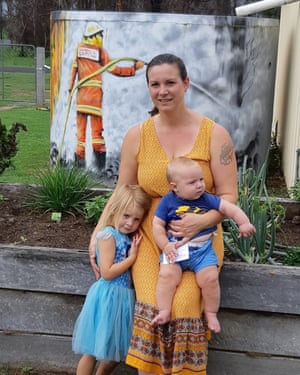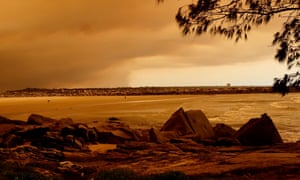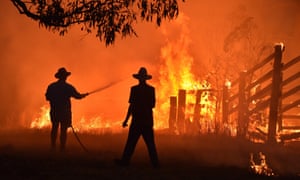The story of coal and climate change is not a tale of two cities, but a tale of two regional Australias
Over summer I spent weeks reporting on the bushfire crisis in northern New South Wales, including the ferocious blazes close to Taree that near destroyed the towns of Bobin and Killabakh through to the Myall Creek fire in the state’s north, which menaced New Italy and Woombah.
I met families with small children who had to flee burning homes in the night. I visited suburban homes filled to the brim with burnt native animals, needing care around the clock. And I interviewed firefighters who broke down and cried recounting efforts to save the homes of friends.
I met families with small children who had to flee burning homes in the night. I visited suburban homes filled to the brim with burnt native animals, needing care around the clock. And I interviewed firefighters who broke down and cried recounting efforts to save the homes of friends.
These people are regional Australians on the frontline of climate change – climate change that is propelled by burning coal – and while the prime minister, Scott Morrison, has acknowledged the government’s climate policies must “evolve”, he maintains that doesn’t mean “writing off a $70bn industry on which regional Australians depend for their livelihood”.
It’s true that many regional Australians rely on jobs created by coalmining. Coalminers are among Australia’s higher paid earners – average salary $125,000. The Bowen Basin coalmining town of Moranbah is the sixth wealthiest postcode in Queensland, with a median weekly average household income of $2,421.
But the regional towns affected by these fires are suffering tremendous economic, emotional and environmental impacts, not least because scores of people in these areas don’t have the resources to deal with hardship. Many of the towns and regions worst hit by summer’s bushfires are among the least prosperous in the country.
The story of coal and climate change is not a tale of two cities, but a tale of two regional Australias.
Page, in northern New South Wales, consistently rates as one of Australia’s most disadvantaged electorates. (According to the University of Canberra’s Natsem data it is the regional electorate with the greatest proportion of people living under the poverty line in NSW.) In the shires of Richmond Valley and the Clarence Valley, 239 homes burnt, while another 84 were damaged
A ‘baptism of fire’
In the village of Rappville, west of Casino, around one in three houses (more than a dozen homes) were destroyed by fires in October. Rappville’s household median weekly income is $725 – less than a third of that in the mining town of Moranbah."I lost all my children’s baby books, their early art work, my things from Sweden. Robert … lost everything his dad had given him"
Tina Haag and her four children evacuated their rented house in 90 minutes after her neighbour warned her the fire was fast approaching on 8 October. Her partner, Robert Collier, was at work at his family’s air-conditioning business.
Haag, who comes from Sweden, met Collier when he was studying in her country. Their two eldest sons, Jesse, now aged six, and Villiam, five, were born there. They moved to the Richmond Valley, where Collier grew up, four years ago. Their two youngest children, Nora, aged two, and Edward, six months, were born in northern New South Wales.

Haag describes the Rappville fire as her “Aussie baptism of fire”.
“You could see the huge ball of smoke over the pub. I tried to pack, but I ended leaving three of the bags I packed. I just grabbed random clothes … the kids went crazy, grabbing everything.”
The family’s possessions were uninsured and Haag says they are now putting themselves together “from scratch” with the support of the government and the Red Cross.
Friends have found the family a nearby house to live in rent-free. Haag describes the process of recovery as ongoing.
“In the beginning it was just pure shock and you don’t realise what you’ve lost ... I lost all my children’s baby books, their early art work, my things from Sweden. Robert’s father had died the year before and he lost everything his dad had given him.”
They visited the ruins of their home the day after the fire. Her two-year-old was the most affected, refusing to eat and not wanting to have her hair brushed.
Four months on and all the children are doing well. Nora now talks about the experience.
“She tells everyone she meets, ‘my house burnt’.”
Haag is convinced the severity of the fires was connected to climate change.
“It’s the same in Sweden, the weather is crazy. The last time we were there, there was a drought. It hasn’t been that dry in 400 years and now they have a winter without snow. And here we also have long droughts.”
She describes the push for new coalmines and a power plant in Queensland as “strange”.
“It’s time the politicians came out with something new, especially after this. They need to look for other solutions, apart from coal, something that’s better for the environment. Living in rural places like this the only thing you hear is ‘stop the coalmining, lock the gates’, and that’s what we’re about too. We believe there are other options.”
The family are committed to staying in Rappville and are looking to buy land and build a new home.
“We want to buy a block and put something nice there. Inspire the town,” Collier says.
Counting the cost of climate change
Coalition ministers have consistently rejected the idea that renewable industries could create more jobs and disperse wealth more evenly across regional Australia than coalmining or that the government could more effectively lobby for global emissions cuts if Australia wasn’t the world’s second biggest coal exporter.The ALP accepts that “coal will continue to play a part within our economy for decades to come”.
When defending coal as a cheap power source and major Australian export, Morrison again and again cites the need to protect the jobs of regional Australians: “I’m not going to put someone’s job at risk, a region’s, town’s future at risk.”
About 7 million people live in regional Australia. The statistics show that on average regional Australians earn less than urban Australians, and also have a lower life expectancy, higher rates of disease and injury, double the national suicide rate, and poorer access to services and infrastructure, and now – as evidenced from the worst bushfire season on record and recent flooding – we are increasingly impacted by the climate crisis.
"The science is there, so please read it and understand it"
Cowper, just south of Page, is New South Wales’ second poorest regional electorate. In its shires of Nambucca, Bellingen, Kempsey and Coffs Harbour, 176 homes burnt in the November bushfires, another 60 houses were damaged. The seat of Lyne, further south again, taking in Taree and Forster is number three on the regional disadvantage scale. There, 125 houses were destroyed, 62 damaged.
Andrew Goodfellow, a bus driver in the Cowper electorate, lost his three-bedroom house in the community of McHugh’s Creek, west of Macksville, on 8 November. The 58-year-old and his dog are living with friends while he considers his future. He had less than half an hour to evacuate.

Goodfellow has been told his insurance wouldn’t cover all losses, and he is still grappling with the destruction.
Goodfellow doubts he will rebuild on his 22 acres and is instead looking to buy in town. He believes climate change played a role in the fires, but also wonders if more hazard reduction burns could have reduced the fuel load in the forests.
He finds the National party’s push for a new coal-fired power station in Queensland laughable, and has a message for Cowper’s Nationals MP, former police officer Pat Conaghan.
“The science is there, so please read it and understand it … why do other countries have alternative technologies, like solar farms, while Australia is dragging its feet and following old-school, coal-fired technology?”
Tourism spending up in smoke
Regional Australia towns are more reliant on tourism dollars than cities, and the bushfires not only destroyed businesses but emptied much of the east coast of visitors over summer. Australian tourism is a $143bn industry – more than double the value of coal exports – and for every dollar spent by tourists, 43 cents goes to regional areas. In short, tourism is vital to the economies of regional communities.
Janette Cullen runs the Café Marina in the surfing/fishing hamlet of Yamba, south of Ballina. For more than a month, the Myall Creek fire burned to the north, frequently cutting the Pacific Highway.
“The visitors were frightened off, but the locals still came when they could get here. The fires basically shortened our peak season from eight weeks to around three, and it was also hard to get supplies in,” she said. “The government hasn’t helped me, but I’m not even sure what grants I could apply for.”
Cullen said she was not happy about talk of a new coal-fired power station for Queensland.
“I think it’s a distraction and I’m tired of the politicians. They are too busy fighting among themselves and while they are fighting, they are not helping us.”

No comments:
Post a Comment